Report on Civil Engineering Project: Contracts, Skills, and Techniques
VerifiedAdded on 2020/01/23
|14
|3633
|737
Report
AI Summary
This report provides a comprehensive overview of civil engineering projects, focusing on the development of essential knowledge and transferable skills crucial for success in the field. It examines various aspects of project management, including feasibility studies, land acquisition, outline design, and detailed design, highlighting the significance of mathematical, leadership, analytical, communication, and problem-solving skills. The report further explores the application of different contract types, such as JCT and NEC, and the use of project planning tools like Gantt charts and PERT diagrams to effectively manage large infrastructural projects. It emphasizes the importance of adhering to project management steps, including construction and handover, to ensure client satisfaction and project success. The report also delves into the roles of finance, consents, and land acquisition, alongside detailed design and construction phases, concluding with the importance of proper project handover procedures. This report is a valuable resource for understanding the intricacies of civil engineering projects and the skills needed to excel in the field.
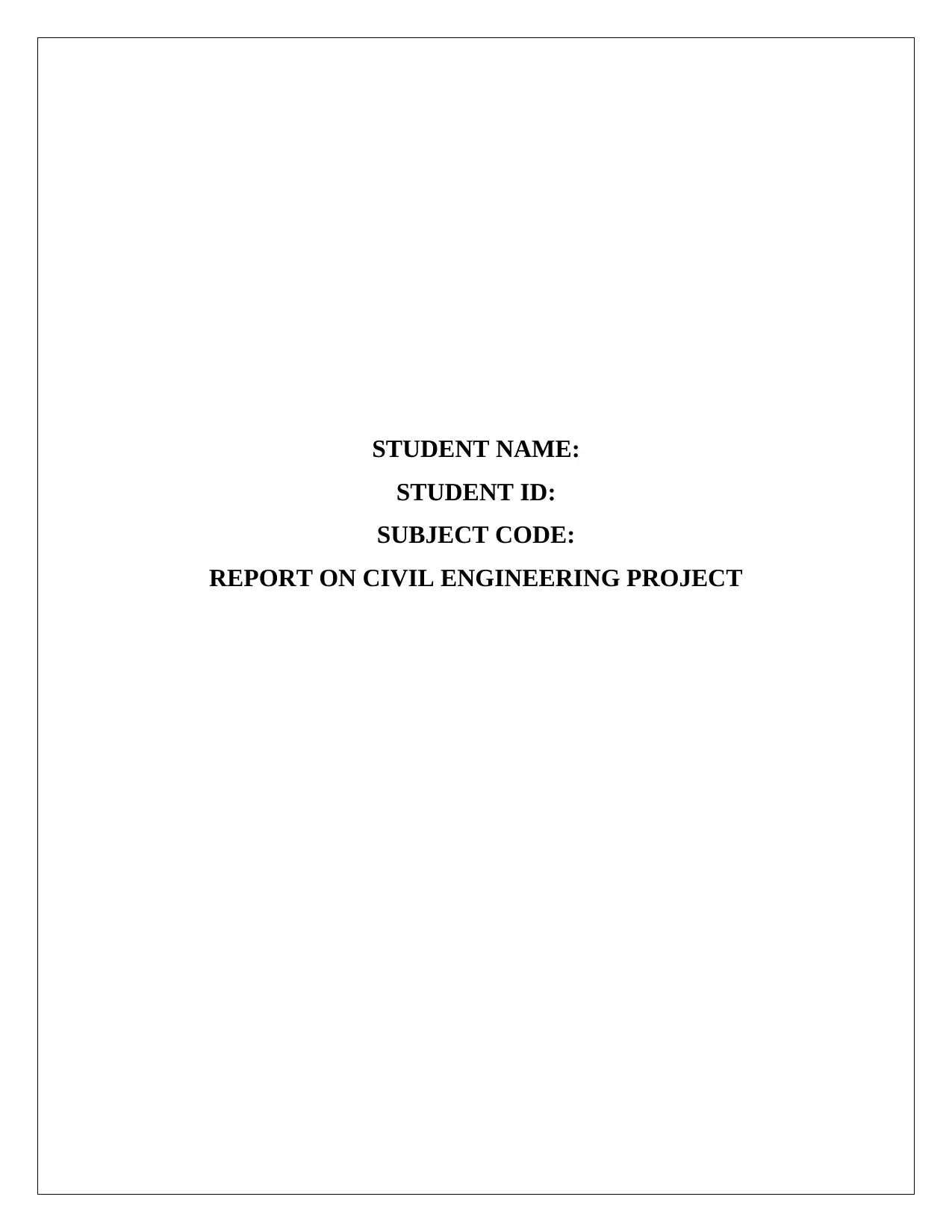
STUDENT NAME:
STUDENT ID:
SUBJECT CODE:
REPORT ON CIVIL ENGINEERING PROJECT
STUDENT ID:
SUBJECT CODE:
REPORT ON CIVIL ENGINEERING PROJECT
Paraphrase This Document
Need a fresh take? Get an instant paraphrase of this document with our AI Paraphraser
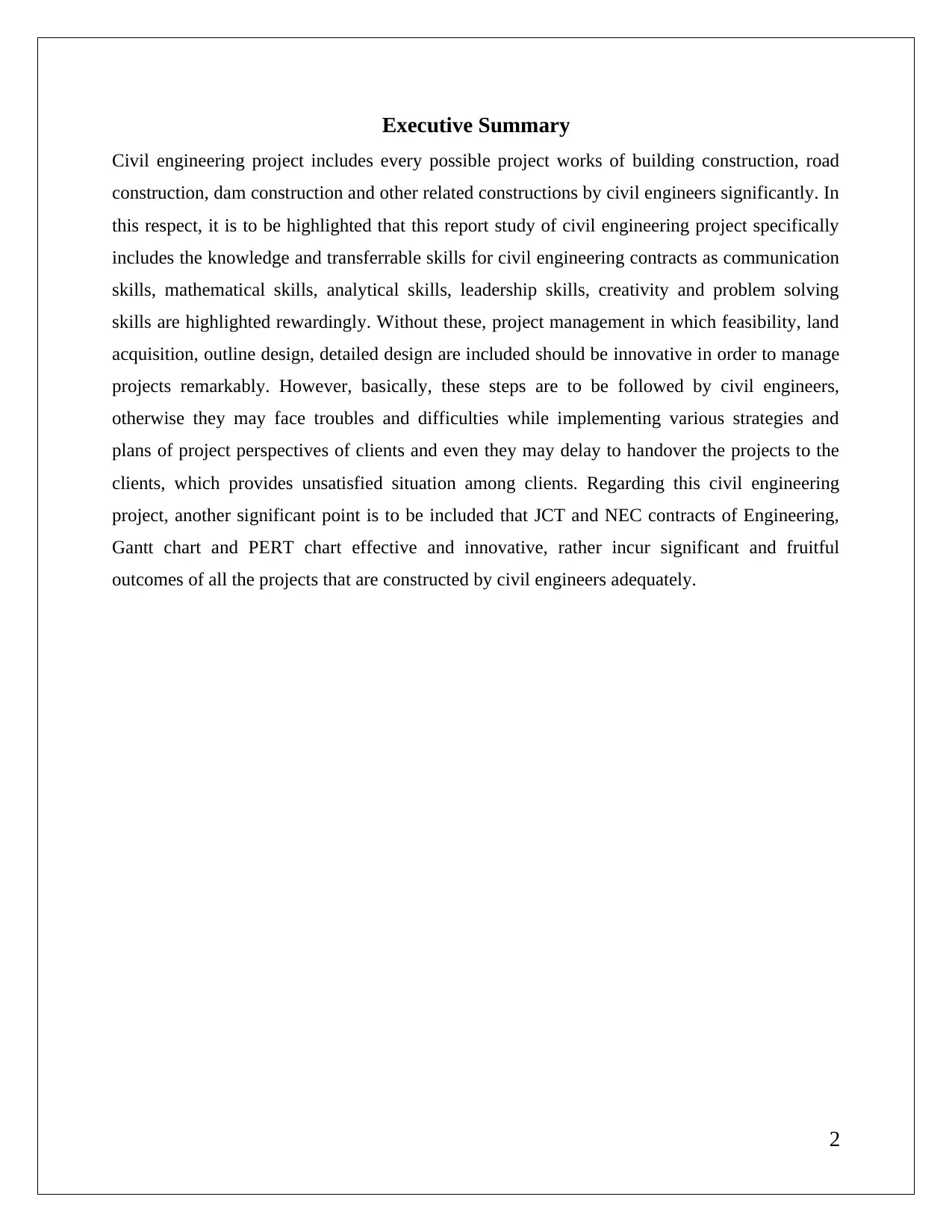
Executive Summary
Civil engineering project includes every possible project works of building construction, road
construction, dam construction and other related constructions by civil engineers significantly. In
this respect, it is to be highlighted that this report study of civil engineering project specifically
includes the knowledge and transferrable skills for civil engineering contracts as communication
skills, mathematical skills, analytical skills, leadership skills, creativity and problem solving
skills are highlighted rewardingly. Without these, project management in which feasibility, land
acquisition, outline design, detailed design are included should be innovative in order to manage
projects remarkably. However, basically, these steps are to be followed by civil engineers,
otherwise they may face troubles and difficulties while implementing various strategies and
plans of project perspectives of clients and even they may delay to handover the projects to the
clients, which provides unsatisfied situation among clients. Regarding this civil engineering
project, another significant point is to be included that JCT and NEC contracts of Engineering,
Gantt chart and PERT chart effective and innovative, rather incur significant and fruitful
outcomes of all the projects that are constructed by civil engineers adequately.
2
Civil engineering project includes every possible project works of building construction, road
construction, dam construction and other related constructions by civil engineers significantly. In
this respect, it is to be highlighted that this report study of civil engineering project specifically
includes the knowledge and transferrable skills for civil engineering contracts as communication
skills, mathematical skills, analytical skills, leadership skills, creativity and problem solving
skills are highlighted rewardingly. Without these, project management in which feasibility, land
acquisition, outline design, detailed design are included should be innovative in order to manage
projects remarkably. However, basically, these steps are to be followed by civil engineers,
otherwise they may face troubles and difficulties while implementing various strategies and
plans of project perspectives of clients and even they may delay to handover the projects to the
clients, which provides unsatisfied situation among clients. Regarding this civil engineering
project, another significant point is to be included that JCT and NEC contracts of Engineering,
Gantt chart and PERT chart effective and innovative, rather incur significant and fruitful
outcomes of all the projects that are constructed by civil engineers adequately.
2
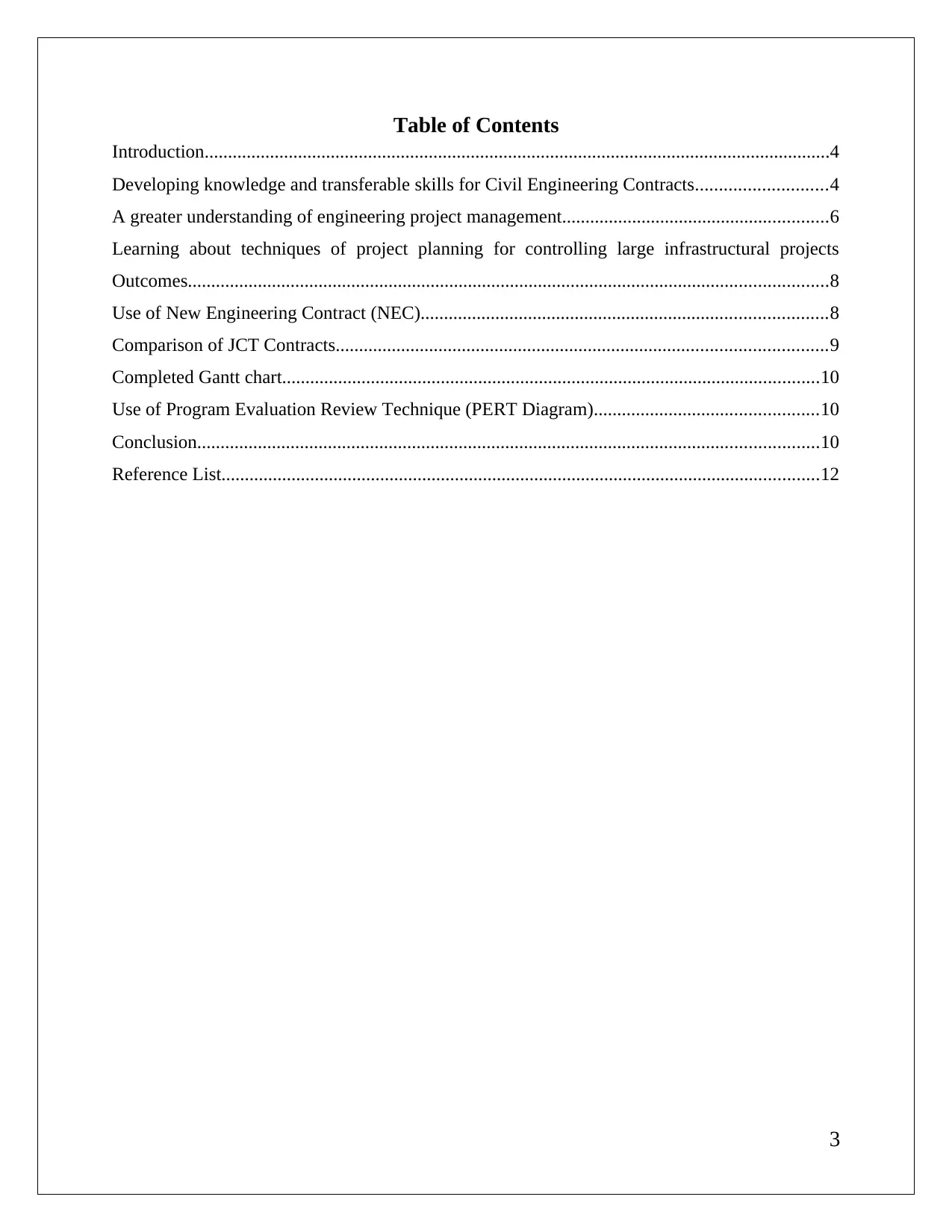
Table of Contents
Introduction......................................................................................................................................4
Developing knowledge and transferable skills for Civil Engineering Contracts............................4
A greater understanding of engineering project management.........................................................6
Learning about techniques of project planning for controlling large infrastructural projects
Outcomes.........................................................................................................................................8
Use of New Engineering Contract (NEC).......................................................................................8
Comparison of JCT Contracts.........................................................................................................9
Completed Gantt chart...................................................................................................................10
Use of Program Evaluation Review Technique (PERT Diagram)................................................10
Conclusion.....................................................................................................................................10
Reference List................................................................................................................................12
3
Introduction......................................................................................................................................4
Developing knowledge and transferable skills for Civil Engineering Contracts............................4
A greater understanding of engineering project management.........................................................6
Learning about techniques of project planning for controlling large infrastructural projects
Outcomes.........................................................................................................................................8
Use of New Engineering Contract (NEC).......................................................................................8
Comparison of JCT Contracts.........................................................................................................9
Completed Gantt chart...................................................................................................................10
Use of Program Evaluation Review Technique (PERT Diagram)................................................10
Conclusion.....................................................................................................................................10
Reference List................................................................................................................................12
3
⊘ This is a preview!⊘
Do you want full access?
Subscribe today to unlock all pages.

Trusted by 1+ million students worldwide
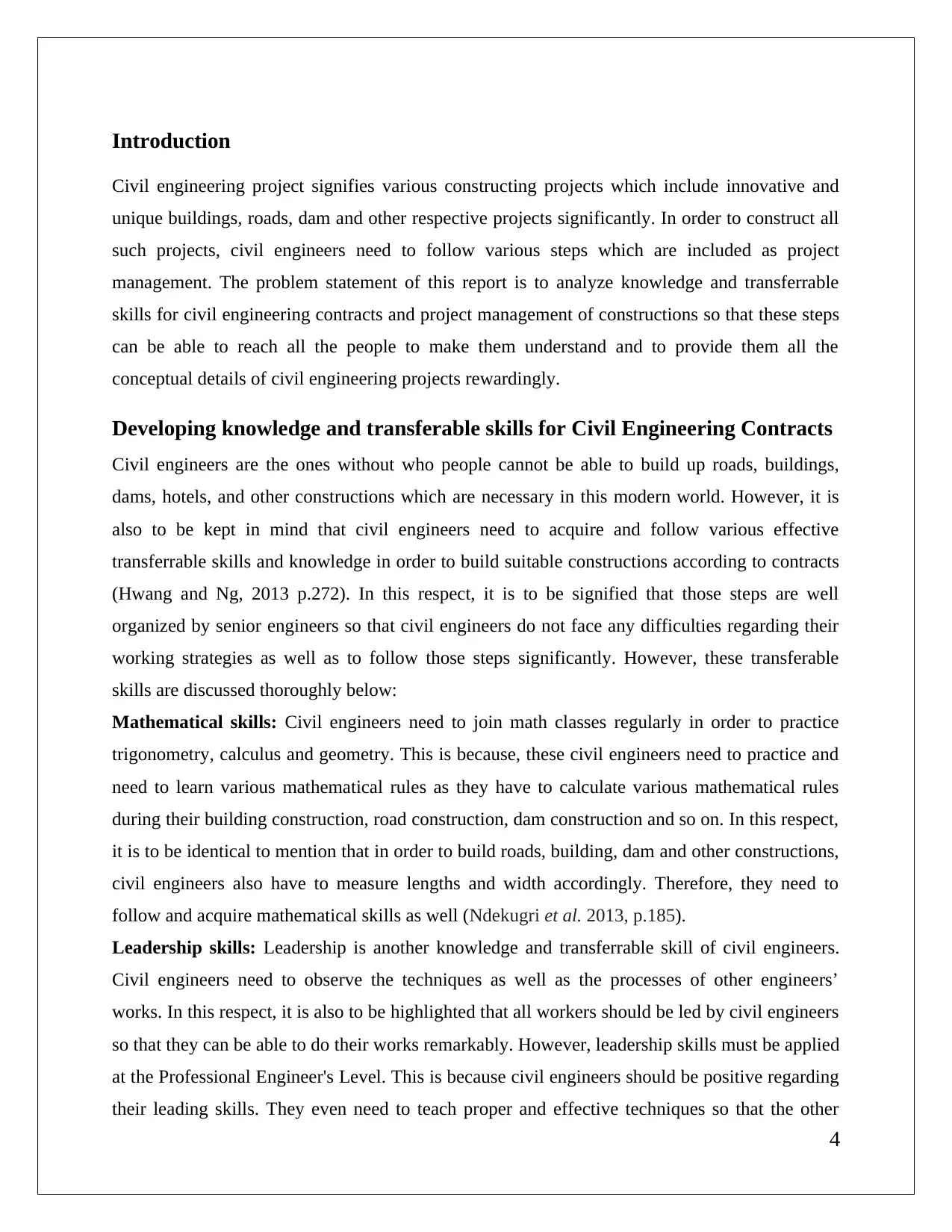
Introduction
Civil engineering project signifies various constructing projects which include innovative and
unique buildings, roads, dam and other respective projects significantly. In order to construct all
such projects, civil engineers need to follow various steps which are included as project
management. The problem statement of this report is to analyze knowledge and transferrable
skills for civil engineering contracts and project management of constructions so that these steps
can be able to reach all the people to make them understand and to provide them all the
conceptual details of civil engineering projects rewardingly.
Developing knowledge and transferable skills for Civil Engineering Contracts
Civil engineers are the ones without who people cannot be able to build up roads, buildings,
dams, hotels, and other constructions which are necessary in this modern world. However, it is
also to be kept in mind that civil engineers need to acquire and follow various effective
transferrable skills and knowledge in order to build suitable constructions according to contracts
(Hwang and Ng, 2013 p.272). In this respect, it is to be signified that those steps are well
organized by senior engineers so that civil engineers do not face any difficulties regarding their
working strategies as well as to follow those steps significantly. However, these transferable
skills are discussed thoroughly below:
Mathematical skills: Civil engineers need to join math classes regularly in order to practice
trigonometry, calculus and geometry. This is because, these civil engineers need to practice and
need to learn various mathematical rules as they have to calculate various mathematical rules
during their building construction, road construction, dam construction and so on. In this respect,
it is to be identical to mention that in order to build roads, building, dam and other constructions,
civil engineers also have to measure lengths and width accordingly. Therefore, they need to
follow and acquire mathematical skills as well (Ndekugri et al. 2013, p.185).
Leadership skills: Leadership is another knowledge and transferrable skill of civil engineers.
Civil engineers need to observe the techniques as well as the processes of other engineers’
works. In this respect, it is also to be highlighted that all workers should be led by civil engineers
so that they can be able to do their works remarkably. However, leadership skills must be applied
at the Professional Engineer's Level. This is because civil engineers should be positive regarding
their leading skills. They even need to teach proper and effective techniques so that the other
4
Civil engineering project signifies various constructing projects which include innovative and
unique buildings, roads, dam and other respective projects significantly. In order to construct all
such projects, civil engineers need to follow various steps which are included as project
management. The problem statement of this report is to analyze knowledge and transferrable
skills for civil engineering contracts and project management of constructions so that these steps
can be able to reach all the people to make them understand and to provide them all the
conceptual details of civil engineering projects rewardingly.
Developing knowledge and transferable skills for Civil Engineering Contracts
Civil engineers are the ones without who people cannot be able to build up roads, buildings,
dams, hotels, and other constructions which are necessary in this modern world. However, it is
also to be kept in mind that civil engineers need to acquire and follow various effective
transferrable skills and knowledge in order to build suitable constructions according to contracts
(Hwang and Ng, 2013 p.272). In this respect, it is to be signified that those steps are well
organized by senior engineers so that civil engineers do not face any difficulties regarding their
working strategies as well as to follow those steps significantly. However, these transferable
skills are discussed thoroughly below:
Mathematical skills: Civil engineers need to join math classes regularly in order to practice
trigonometry, calculus and geometry. This is because, these civil engineers need to practice and
need to learn various mathematical rules as they have to calculate various mathematical rules
during their building construction, road construction, dam construction and so on. In this respect,
it is to be identical to mention that in order to build roads, building, dam and other constructions,
civil engineers also have to measure lengths and width accordingly. Therefore, they need to
follow and acquire mathematical skills as well (Ndekugri et al. 2013, p.185).
Leadership skills: Leadership is another knowledge and transferrable skill of civil engineers.
Civil engineers need to observe the techniques as well as the processes of other engineers’
works. In this respect, it is also to be highlighted that all workers should be led by civil engineers
so that they can be able to do their works remarkably. However, leadership skills must be applied
at the Professional Engineer's Level. This is because civil engineers should be positive regarding
their leading skills. They even need to teach proper and effective techniques so that the other
4
Paraphrase This Document
Need a fresh take? Get an instant paraphrase of this document with our AI Paraphraser
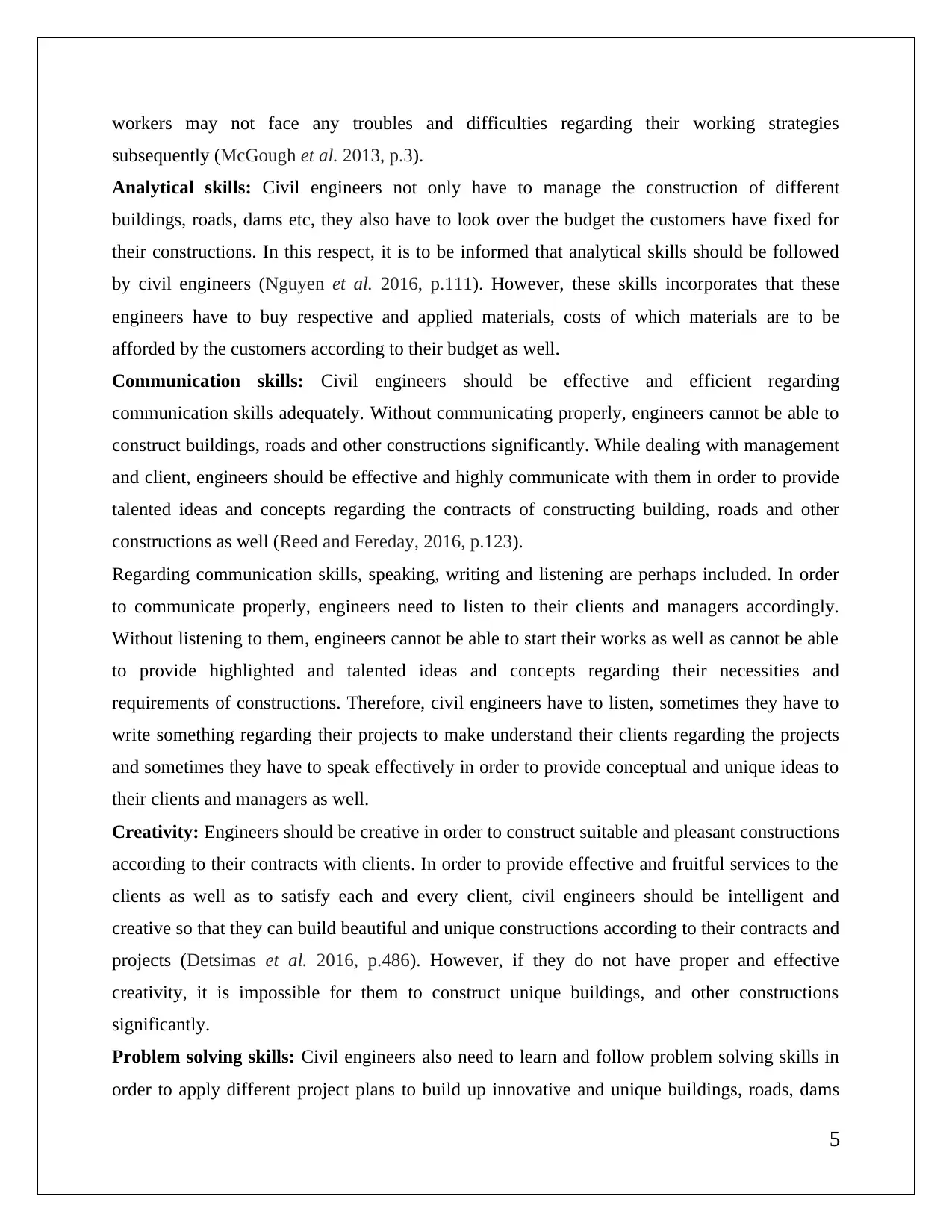
workers may not face any troubles and difficulties regarding their working strategies
subsequently (McGough et al. 2013, p.3).
Analytical skills: Civil engineers not only have to manage the construction of different
buildings, roads, dams etc, they also have to look over the budget the customers have fixed for
their constructions. In this respect, it is to be informed that analytical skills should be followed
by civil engineers (Nguyen et al. 2016, p.111). However, these skills incorporates that these
engineers have to buy respective and applied materials, costs of which materials are to be
afforded by the customers according to their budget as well.
Communication skills: Civil engineers should be effective and efficient regarding
communication skills adequately. Without communicating properly, engineers cannot be able to
construct buildings, roads and other constructions significantly. While dealing with management
and client, engineers should be effective and highly communicate with them in order to provide
talented ideas and concepts regarding the contracts of constructing building, roads and other
constructions as well (Reed and Fereday, 2016, p.123).
Regarding communication skills, speaking, writing and listening are perhaps included. In order
to communicate properly, engineers need to listen to their clients and managers accordingly.
Without listening to them, engineers cannot be able to start their works as well as cannot be able
to provide highlighted and talented ideas and concepts regarding their necessities and
requirements of constructions. Therefore, civil engineers have to listen, sometimes they have to
write something regarding their projects to make understand their clients regarding the projects
and sometimes they have to speak effectively in order to provide conceptual and unique ideas to
their clients and managers as well.
Creativity: Engineers should be creative in order to construct suitable and pleasant constructions
according to their contracts with clients. In order to provide effective and fruitful services to the
clients as well as to satisfy each and every client, civil engineers should be intelligent and
creative so that they can build beautiful and unique constructions according to their contracts and
projects (Detsimas et al. 2016, p.486). However, if they do not have proper and effective
creativity, it is impossible for them to construct unique buildings, and other constructions
significantly.
Problem solving skills: Civil engineers also need to learn and follow problem solving skills in
order to apply different project plans to build up innovative and unique buildings, roads, dams
5
subsequently (McGough et al. 2013, p.3).
Analytical skills: Civil engineers not only have to manage the construction of different
buildings, roads, dams etc, they also have to look over the budget the customers have fixed for
their constructions. In this respect, it is to be informed that analytical skills should be followed
by civil engineers (Nguyen et al. 2016, p.111). However, these skills incorporates that these
engineers have to buy respective and applied materials, costs of which materials are to be
afforded by the customers according to their budget as well.
Communication skills: Civil engineers should be effective and efficient regarding
communication skills adequately. Without communicating properly, engineers cannot be able to
construct buildings, roads and other constructions significantly. While dealing with management
and client, engineers should be effective and highly communicate with them in order to provide
talented ideas and concepts regarding the contracts of constructing building, roads and other
constructions as well (Reed and Fereday, 2016, p.123).
Regarding communication skills, speaking, writing and listening are perhaps included. In order
to communicate properly, engineers need to listen to their clients and managers accordingly.
Without listening to them, engineers cannot be able to start their works as well as cannot be able
to provide highlighted and talented ideas and concepts regarding their necessities and
requirements of constructions. Therefore, civil engineers have to listen, sometimes they have to
write something regarding their projects to make understand their clients regarding the projects
and sometimes they have to speak effectively in order to provide conceptual and unique ideas to
their clients and managers as well.
Creativity: Engineers should be creative in order to construct suitable and pleasant constructions
according to their contracts with clients. In order to provide effective and fruitful services to the
clients as well as to satisfy each and every client, civil engineers should be intelligent and
creative so that they can build beautiful and unique constructions according to their contracts and
projects (Detsimas et al. 2016, p.486). However, if they do not have proper and effective
creativity, it is impossible for them to construct unique buildings, and other constructions
significantly.
Problem solving skills: Civil engineers also need to learn and follow problem solving skills in
order to apply different project plans to build up innovative and unique buildings, roads, dams
5
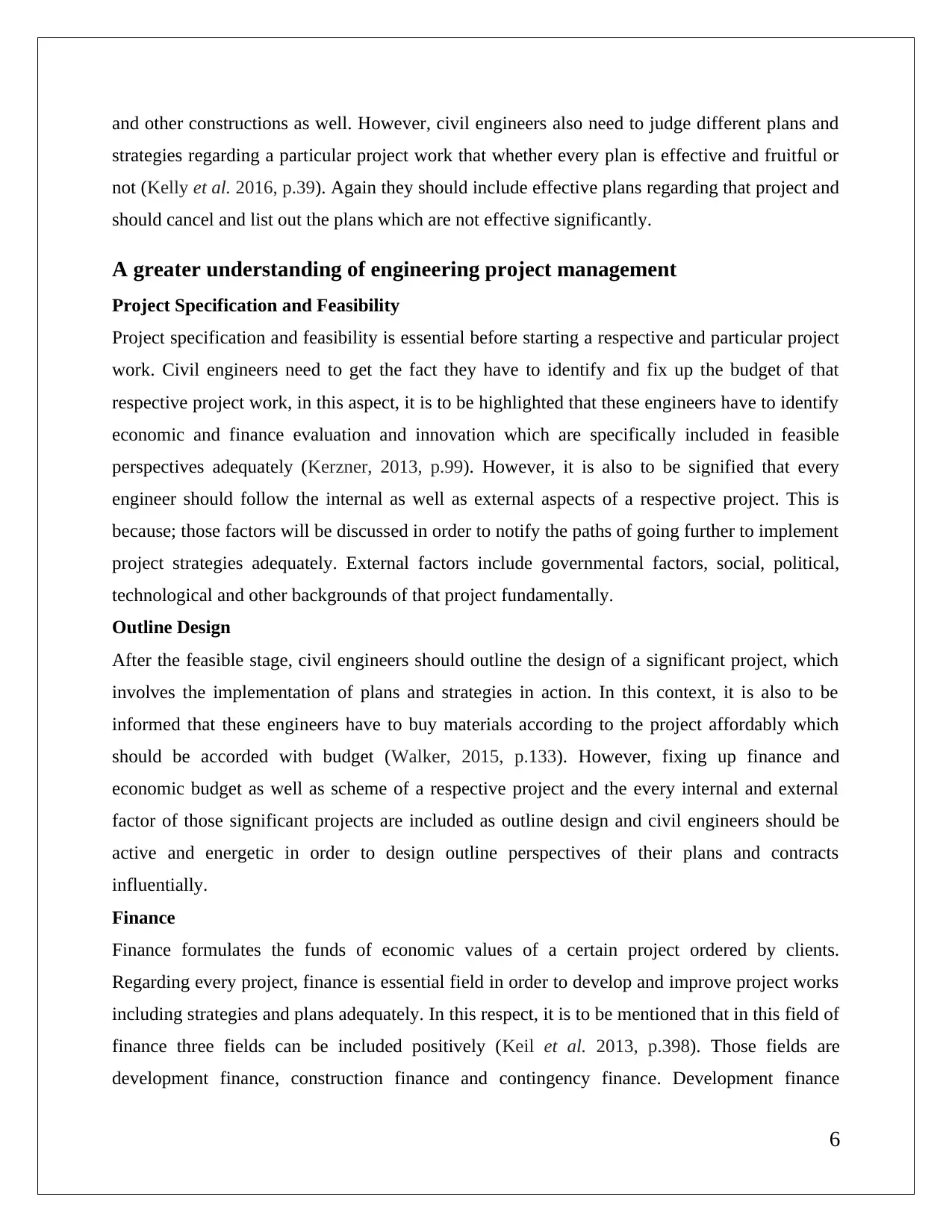
and other constructions as well. However, civil engineers also need to judge different plans and
strategies regarding a particular project work that whether every plan is effective and fruitful or
not (Kelly et al. 2016, p.39). Again they should include effective plans regarding that project and
should cancel and list out the plans which are not effective significantly.
A greater understanding of engineering project management
Project Specification and Feasibility
Project specification and feasibility is essential before starting a respective and particular project
work. Civil engineers need to get the fact they have to identify and fix up the budget of that
respective project work, in this aspect, it is to be highlighted that these engineers have to identify
economic and finance evaluation and innovation which are specifically included in feasible
perspectives adequately (Kerzner, 2013, p.99). However, it is also to be signified that every
engineer should follow the internal as well as external aspects of a respective project. This is
because; those factors will be discussed in order to notify the paths of going further to implement
project strategies adequately. External factors include governmental factors, social, political,
technological and other backgrounds of that project fundamentally.
Outline Design
After the feasible stage, civil engineers should outline the design of a significant project, which
involves the implementation of plans and strategies in action. In this context, it is also to be
informed that these engineers have to buy materials according to the project affordably which
should be accorded with budget (Walker, 2015, p.133). However, fixing up finance and
economic budget as well as scheme of a respective project and the every internal and external
factor of those significant projects are included as outline design and civil engineers should be
active and energetic in order to design outline perspectives of their plans and contracts
influentially.
Finance
Finance formulates the funds of economic values of a certain project ordered by clients.
Regarding every project, finance is essential field in order to develop and improve project works
including strategies and plans adequately. In this respect, it is to be mentioned that in this field of
finance three fields can be included positively (Keil et al. 2013, p.398). Those fields are
development finance, construction finance and contingency finance. Development finance
6
strategies regarding a particular project work that whether every plan is effective and fruitful or
not (Kelly et al. 2016, p.39). Again they should include effective plans regarding that project and
should cancel and list out the plans which are not effective significantly.
A greater understanding of engineering project management
Project Specification and Feasibility
Project specification and feasibility is essential before starting a respective and particular project
work. Civil engineers need to get the fact they have to identify and fix up the budget of that
respective project work, in this aspect, it is to be highlighted that these engineers have to identify
economic and finance evaluation and innovation which are specifically included in feasible
perspectives adequately (Kerzner, 2013, p.99). However, it is also to be signified that every
engineer should follow the internal as well as external aspects of a respective project. This is
because; those factors will be discussed in order to notify the paths of going further to implement
project strategies adequately. External factors include governmental factors, social, political,
technological and other backgrounds of that project fundamentally.
Outline Design
After the feasible stage, civil engineers should outline the design of a significant project, which
involves the implementation of plans and strategies in action. In this context, it is also to be
informed that these engineers have to buy materials according to the project affordably which
should be accorded with budget (Walker, 2015, p.133). However, fixing up finance and
economic budget as well as scheme of a respective project and the every internal and external
factor of those significant projects are included as outline design and civil engineers should be
active and energetic in order to design outline perspectives of their plans and contracts
influentially.
Finance
Finance formulates the funds of economic values of a certain project ordered by clients.
Regarding every project, finance is essential field in order to develop and improve project works
including strategies and plans adequately. In this respect, it is to be mentioned that in this field of
finance three fields can be included positively (Keil et al. 2013, p.398). Those fields are
development finance, construction finance and contingency finance. Development finance
6
⊘ This is a preview!⊘
Do you want full access?
Subscribe today to unlock all pages.

Trusted by 1+ million students worldwide
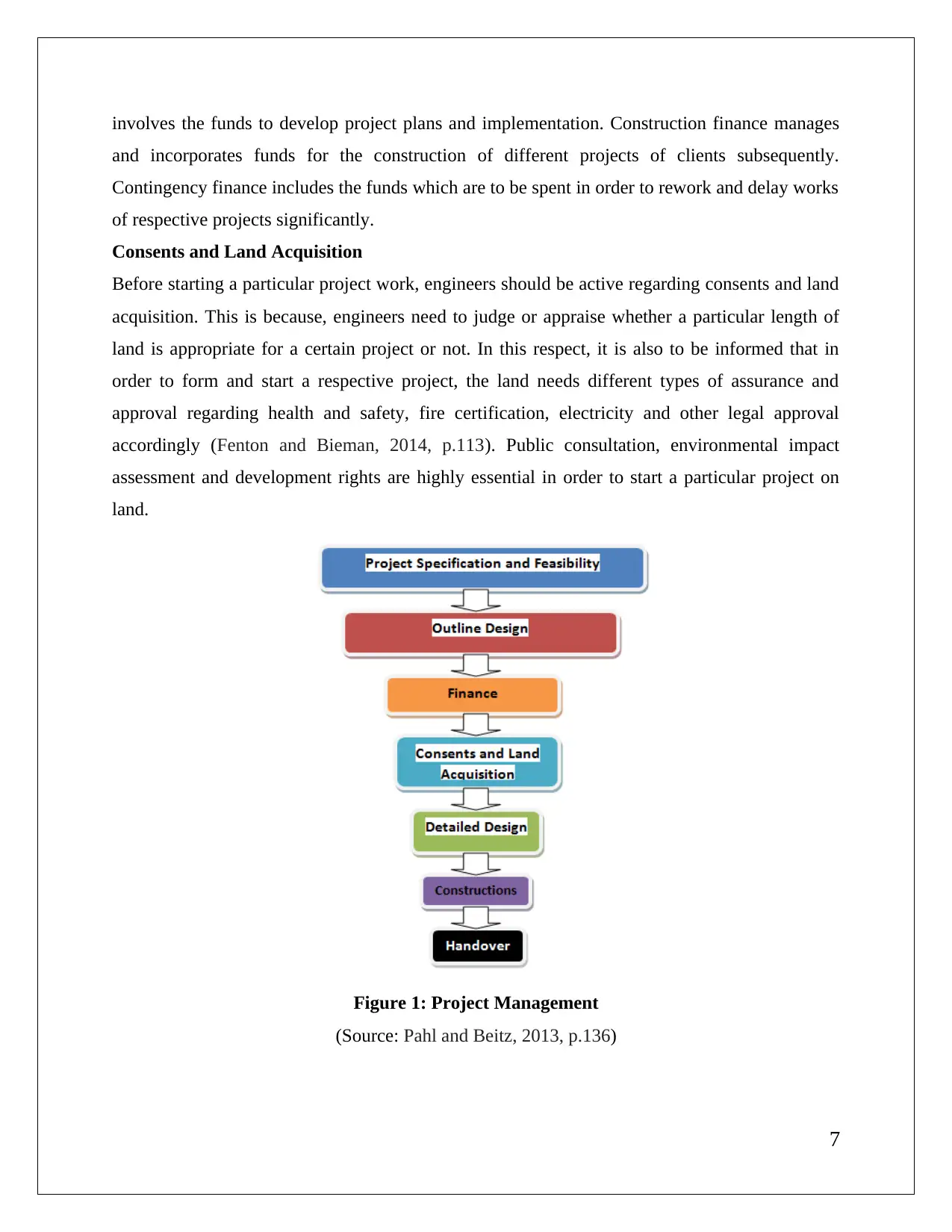
involves the funds to develop project plans and implementation. Construction finance manages
and incorporates funds for the construction of different projects of clients subsequently.
Contingency finance includes the funds which are to be spent in order to rework and delay works
of respective projects significantly.
Consents and Land Acquisition
Before starting a particular project work, engineers should be active regarding consents and land
acquisition. This is because, engineers need to judge or appraise whether a particular length of
land is appropriate for a certain project or not. In this respect, it is also to be informed that in
order to form and start a respective project, the land needs different types of assurance and
approval regarding health and safety, fire certification, electricity and other legal approval
accordingly (Fenton and Bieman, 2014, p.113). Public consultation, environmental impact
assessment and development rights are highly essential in order to start a particular project on
land.
Figure 1: Project Management
(Source: Pahl and Beitz, 2013, p.136)
7
and incorporates funds for the construction of different projects of clients subsequently.
Contingency finance includes the funds which are to be spent in order to rework and delay works
of respective projects significantly.
Consents and Land Acquisition
Before starting a particular project work, engineers should be active regarding consents and land
acquisition. This is because, engineers need to judge or appraise whether a particular length of
land is appropriate for a certain project or not. In this respect, it is also to be informed that in
order to form and start a respective project, the land needs different types of assurance and
approval regarding health and safety, fire certification, electricity and other legal approval
accordingly (Fenton and Bieman, 2014, p.113). Public consultation, environmental impact
assessment and development rights are highly essential in order to start a particular project on
land.
Figure 1: Project Management
(Source: Pahl and Beitz, 2013, p.136)
7
Paraphrase This Document
Need a fresh take? Get an instant paraphrase of this document with our AI Paraphraser
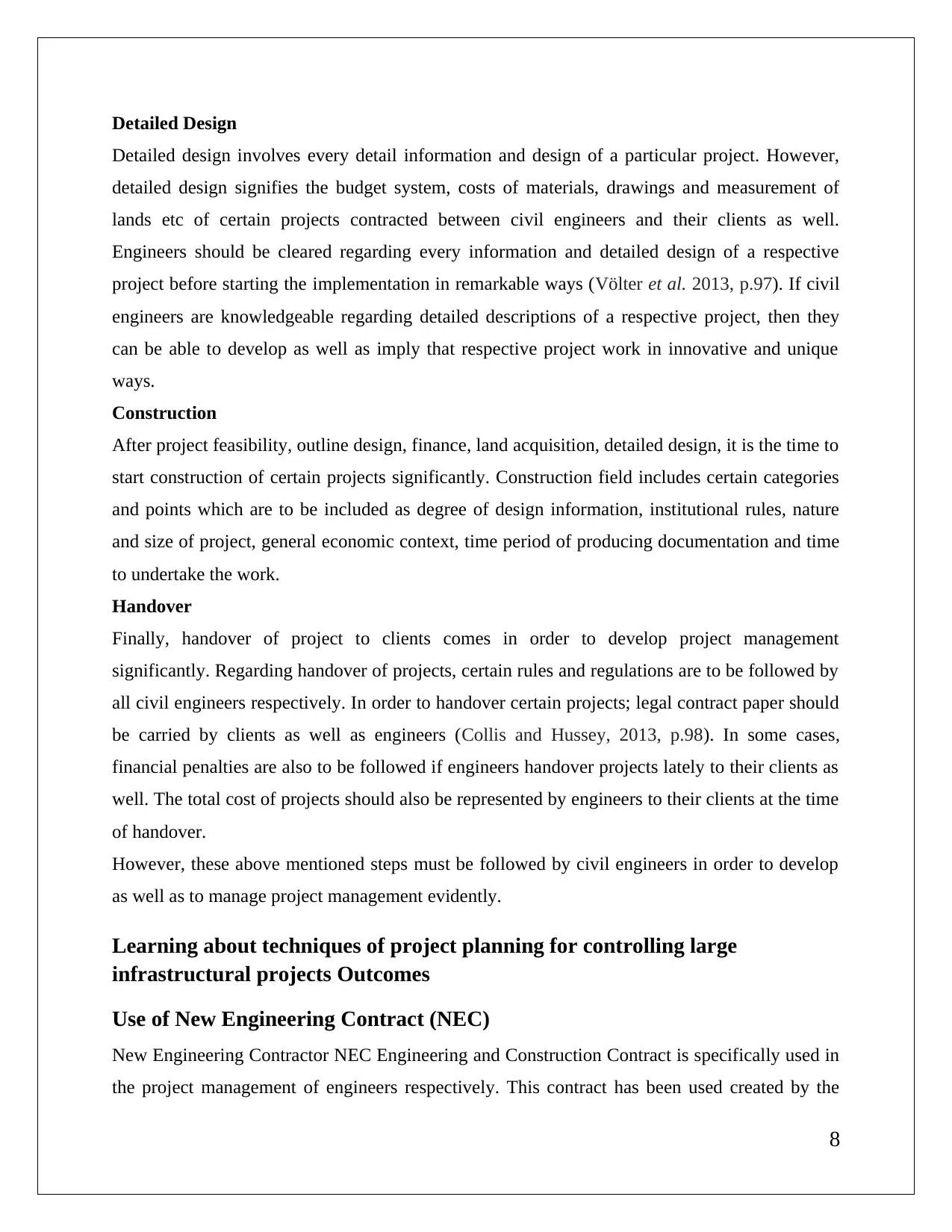
Detailed Design
Detailed design involves every detail information and design of a particular project. However,
detailed design signifies the budget system, costs of materials, drawings and measurement of
lands etc of certain projects contracted between civil engineers and their clients as well.
Engineers should be cleared regarding every information and detailed design of a respective
project before starting the implementation in remarkable ways (Völter et al. 2013, p.97). If civil
engineers are knowledgeable regarding detailed descriptions of a respective project, then they
can be able to develop as well as imply that respective project work in innovative and unique
ways.
Construction
After project feasibility, outline design, finance, land acquisition, detailed design, it is the time to
start construction of certain projects significantly. Construction field includes certain categories
and points which are to be included as degree of design information, institutional rules, nature
and size of project, general economic context, time period of producing documentation and time
to undertake the work.
Handover
Finally, handover of project to clients comes in order to develop project management
significantly. Regarding handover of projects, certain rules and regulations are to be followed by
all civil engineers respectively. In order to handover certain projects; legal contract paper should
be carried by clients as well as engineers (Collis and Hussey, 2013, p.98). In some cases,
financial penalties are also to be followed if engineers handover projects lately to their clients as
well. The total cost of projects should also be represented by engineers to their clients at the time
of handover.
However, these above mentioned steps must be followed by civil engineers in order to develop
as well as to manage project management evidently.
Learning about techniques of project planning for controlling large
infrastructural projects Outcomes
Use of New Engineering Contract (NEC)
New Engineering Contractor NEC Engineering and Construction Contract is specifically used in
the project management of engineers respectively. This contract has been used created by the
8
Detailed design involves every detail information and design of a particular project. However,
detailed design signifies the budget system, costs of materials, drawings and measurement of
lands etc of certain projects contracted between civil engineers and their clients as well.
Engineers should be cleared regarding every information and detailed design of a respective
project before starting the implementation in remarkable ways (Völter et al. 2013, p.97). If civil
engineers are knowledgeable regarding detailed descriptions of a respective project, then they
can be able to develop as well as imply that respective project work in innovative and unique
ways.
Construction
After project feasibility, outline design, finance, land acquisition, detailed design, it is the time to
start construction of certain projects significantly. Construction field includes certain categories
and points which are to be included as degree of design information, institutional rules, nature
and size of project, general economic context, time period of producing documentation and time
to undertake the work.
Handover
Finally, handover of project to clients comes in order to develop project management
significantly. Regarding handover of projects, certain rules and regulations are to be followed by
all civil engineers respectively. In order to handover certain projects; legal contract paper should
be carried by clients as well as engineers (Collis and Hussey, 2013, p.98). In some cases,
financial penalties are also to be followed if engineers handover projects lately to their clients as
well. The total cost of projects should also be represented by engineers to their clients at the time
of handover.
However, these above mentioned steps must be followed by civil engineers in order to develop
as well as to manage project management evidently.
Learning about techniques of project planning for controlling large
infrastructural projects Outcomes
Use of New Engineering Contract (NEC)
New Engineering Contractor NEC Engineering and Construction Contract is specifically used in
the project management of engineers respectively. This contract has been used created by the
8
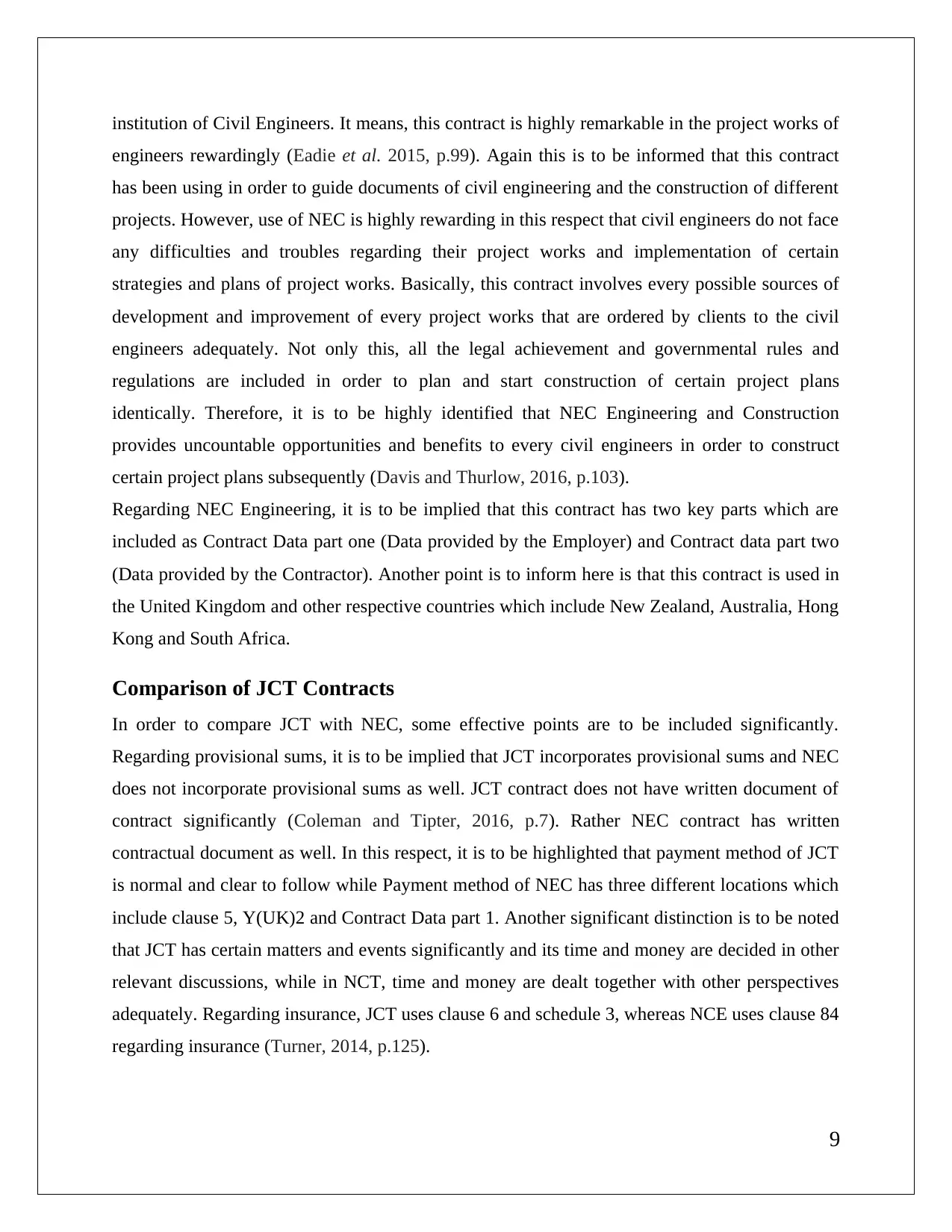
institution of Civil Engineers. It means, this contract is highly remarkable in the project works of
engineers rewardingly (Eadie et al. 2015, p.99). Again this is to be informed that this contract
has been using in order to guide documents of civil engineering and the construction of different
projects. However, use of NEC is highly rewarding in this respect that civil engineers do not face
any difficulties and troubles regarding their project works and implementation of certain
strategies and plans of project works. Basically, this contract involves every possible sources of
development and improvement of every project works that are ordered by clients to the civil
engineers adequately. Not only this, all the legal achievement and governmental rules and
regulations are included in order to plan and start construction of certain project plans
identically. Therefore, it is to be highly identified that NEC Engineering and Construction
provides uncountable opportunities and benefits to every civil engineers in order to construct
certain project plans subsequently (Davis and Thurlow, 2016, p.103).
Regarding NEC Engineering, it is to be implied that this contract has two key parts which are
included as Contract Data part one (Data provided by the Employer) and Contract data part two
(Data provided by the Contractor). Another point is to inform here is that this contract is used in
the United Kingdom and other respective countries which include New Zealand, Australia, Hong
Kong and South Africa.
Comparison of JCT Contracts
In order to compare JCT with NEC, some effective points are to be included significantly.
Regarding provisional sums, it is to be implied that JCT incorporates provisional sums and NEC
does not incorporate provisional sums as well. JCT contract does not have written document of
contract significantly (Coleman and Tipter, 2016, p.7). Rather NEC contract has written
contractual document as well. In this respect, it is to be highlighted that payment method of JCT
is normal and clear to follow while Payment method of NEC has three different locations which
include clause 5, Y(UK)2 and Contract Data part 1. Another significant distinction is to be noted
that JCT has certain matters and events significantly and its time and money are decided in other
relevant discussions, while in NCT, time and money are dealt together with other perspectives
adequately. Regarding insurance, JCT uses clause 6 and schedule 3, whereas NCE uses clause 84
regarding insurance (Turner, 2014, p.125).
9
engineers rewardingly (Eadie et al. 2015, p.99). Again this is to be informed that this contract
has been using in order to guide documents of civil engineering and the construction of different
projects. However, use of NEC is highly rewarding in this respect that civil engineers do not face
any difficulties and troubles regarding their project works and implementation of certain
strategies and plans of project works. Basically, this contract involves every possible sources of
development and improvement of every project works that are ordered by clients to the civil
engineers adequately. Not only this, all the legal achievement and governmental rules and
regulations are included in order to plan and start construction of certain project plans
identically. Therefore, it is to be highly identified that NEC Engineering and Construction
provides uncountable opportunities and benefits to every civil engineers in order to construct
certain project plans subsequently (Davis and Thurlow, 2016, p.103).
Regarding NEC Engineering, it is to be implied that this contract has two key parts which are
included as Contract Data part one (Data provided by the Employer) and Contract data part two
(Data provided by the Contractor). Another point is to inform here is that this contract is used in
the United Kingdom and other respective countries which include New Zealand, Australia, Hong
Kong and South Africa.
Comparison of JCT Contracts
In order to compare JCT with NEC, some effective points are to be included significantly.
Regarding provisional sums, it is to be implied that JCT incorporates provisional sums and NEC
does not incorporate provisional sums as well. JCT contract does not have written document of
contract significantly (Coleman and Tipter, 2016, p.7). Rather NEC contract has written
contractual document as well. In this respect, it is to be highlighted that payment method of JCT
is normal and clear to follow while Payment method of NEC has three different locations which
include clause 5, Y(UK)2 and Contract Data part 1. Another significant distinction is to be noted
that JCT has certain matters and events significantly and its time and money are decided in other
relevant discussions, while in NCT, time and money are dealt together with other perspectives
adequately. Regarding insurance, JCT uses clause 6 and schedule 3, whereas NCE uses clause 84
regarding insurance (Turner, 2014, p.125).
9
⊘ This is a preview!⊘
Do you want full access?
Subscribe today to unlock all pages.

Trusted by 1+ million students worldwide
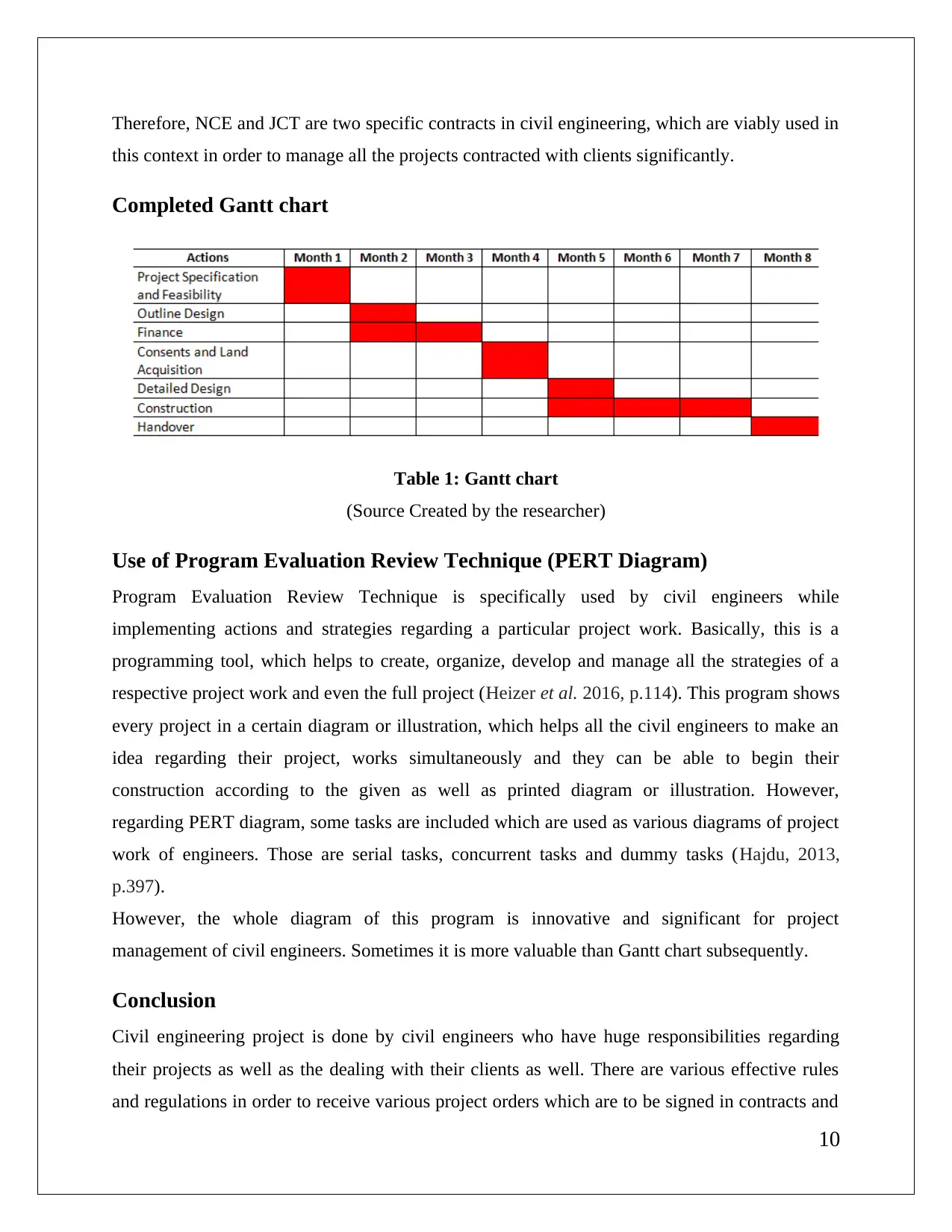
Therefore, NCE and JCT are two specific contracts in civil engineering, which are viably used in
this context in order to manage all the projects contracted with clients significantly.
Completed Gantt chart
Table 1: Gantt chart
(Source Created by the researcher)
Use of Program Evaluation Review Technique (PERT Diagram)
Program Evaluation Review Technique is specifically used by civil engineers while
implementing actions and strategies regarding a particular project work. Basically, this is a
programming tool, which helps to create, organize, develop and manage all the strategies of a
respective project work and even the full project (Heizer et al. 2016, p.114). This program shows
every project in a certain diagram or illustration, which helps all the civil engineers to make an
idea regarding their project, works simultaneously and they can be able to begin their
construction according to the given as well as printed diagram or illustration. However,
regarding PERT diagram, some tasks are included which are used as various diagrams of project
work of engineers. Those are serial tasks, concurrent tasks and dummy tasks (Hajdu, 2013,
p.397).
However, the whole diagram of this program is innovative and significant for project
management of civil engineers. Sometimes it is more valuable than Gantt chart subsequently.
Conclusion
Civil engineering project is done by civil engineers who have huge responsibilities regarding
their projects as well as the dealing with their clients as well. There are various effective rules
and regulations in order to receive various project orders which are to be signed in contracts and
10
this context in order to manage all the projects contracted with clients significantly.
Completed Gantt chart
Table 1: Gantt chart
(Source Created by the researcher)
Use of Program Evaluation Review Technique (PERT Diagram)
Program Evaluation Review Technique is specifically used by civil engineers while
implementing actions and strategies regarding a particular project work. Basically, this is a
programming tool, which helps to create, organize, develop and manage all the strategies of a
respective project work and even the full project (Heizer et al. 2016, p.114). This program shows
every project in a certain diagram or illustration, which helps all the civil engineers to make an
idea regarding their project, works simultaneously and they can be able to begin their
construction according to the given as well as printed diagram or illustration. However,
regarding PERT diagram, some tasks are included which are used as various diagrams of project
work of engineers. Those are serial tasks, concurrent tasks and dummy tasks (Hajdu, 2013,
p.397).
However, the whole diagram of this program is innovative and significant for project
management of civil engineers. Sometimes it is more valuable than Gantt chart subsequently.
Conclusion
Civil engineering project is done by civil engineers who have huge responsibilities regarding
their projects as well as the dealing with their clients as well. There are various effective rules
and regulations in order to receive various project orders which are to be signed in contracts and
10
Paraphrase This Document
Need a fresh take? Get an instant paraphrase of this document with our AI Paraphraser
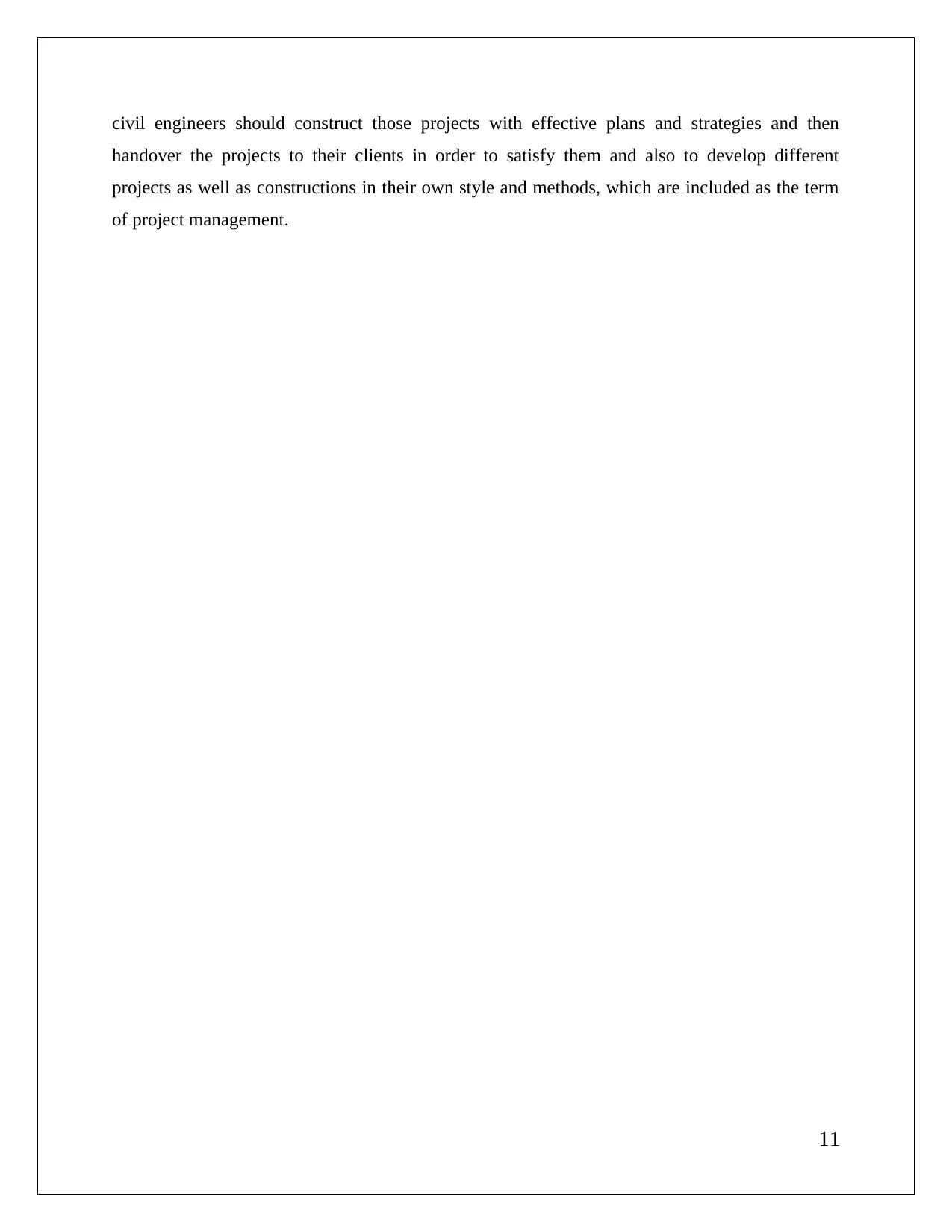
civil engineers should construct those projects with effective plans and strategies and then
handover the projects to their clients in order to satisfy them and also to develop different
projects as well as constructions in their own style and methods, which are included as the term
of project management.
11
handover the projects to their clients in order to satisfy them and also to develop different
projects as well as constructions in their own style and methods, which are included as the term
of project management.
11
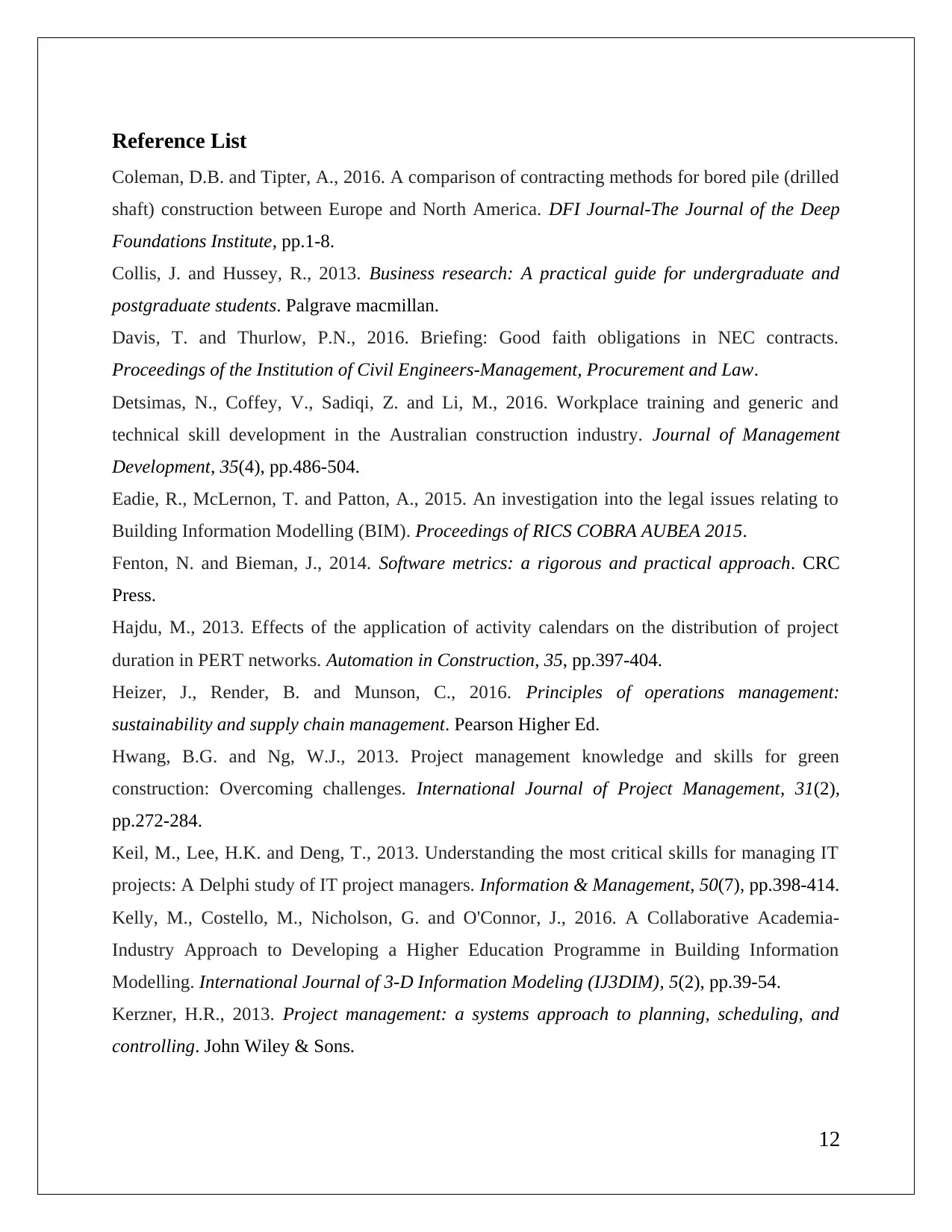
Reference List
Coleman, D.B. and Tipter, A., 2016. A comparison of contracting methods for bored pile (drilled
shaft) construction between Europe and North America. DFI Journal-The Journal of the Deep
Foundations Institute, pp.1-8.
Collis, J. and Hussey, R., 2013. Business research: A practical guide for undergraduate and
postgraduate students. Palgrave macmillan.
Davis, T. and Thurlow, P.N., 2016. Briefing: Good faith obligations in NEC contracts.
Proceedings of the Institution of Civil Engineers-Management, Procurement and Law.
Detsimas, N., Coffey, V., Sadiqi, Z. and Li, M., 2016. Workplace training and generic and
technical skill development in the Australian construction industry. Journal of Management
Development, 35(4), pp.486-504.
Eadie, R., McLernon, T. and Patton, A., 2015. An investigation into the legal issues relating to
Building Information Modelling (BIM). Proceedings of RICS COBRA AUBEA 2015.
Fenton, N. and Bieman, J., 2014. Software metrics: a rigorous and practical approach. CRC
Press.
Hajdu, M., 2013. Effects of the application of activity calendars on the distribution of project
duration in PERT networks. Automation in Construction, 35, pp.397-404.
Heizer, J., Render, B. and Munson, C., 2016. Principles of operations management:
sustainability and supply chain management. Pearson Higher Ed.
Hwang, B.G. and Ng, W.J., 2013. Project management knowledge and skills for green
construction: Overcoming challenges. International Journal of Project Management, 31(2),
pp.272-284.
Keil, M., Lee, H.K. and Deng, T., 2013. Understanding the most critical skills for managing IT
projects: A Delphi study of IT project managers. Information & Management, 50(7), pp.398-414.
Kelly, M., Costello, M., Nicholson, G. and O'Connor, J., 2016. A Collaborative Academia-
Industry Approach to Developing a Higher Education Programme in Building Information
Modelling. International Journal of 3-D Information Modeling (IJ3DIM), 5(2), pp.39-54.
Kerzner, H.R., 2013. Project management: a systems approach to planning, scheduling, and
controlling. John Wiley & Sons.
12
Coleman, D.B. and Tipter, A., 2016. A comparison of contracting methods for bored pile (drilled
shaft) construction between Europe and North America. DFI Journal-The Journal of the Deep
Foundations Institute, pp.1-8.
Collis, J. and Hussey, R., 2013. Business research: A practical guide for undergraduate and
postgraduate students. Palgrave macmillan.
Davis, T. and Thurlow, P.N., 2016. Briefing: Good faith obligations in NEC contracts.
Proceedings of the Institution of Civil Engineers-Management, Procurement and Law.
Detsimas, N., Coffey, V., Sadiqi, Z. and Li, M., 2016. Workplace training and generic and
technical skill development in the Australian construction industry. Journal of Management
Development, 35(4), pp.486-504.
Eadie, R., McLernon, T. and Patton, A., 2015. An investigation into the legal issues relating to
Building Information Modelling (BIM). Proceedings of RICS COBRA AUBEA 2015.
Fenton, N. and Bieman, J., 2014. Software metrics: a rigorous and practical approach. CRC
Press.
Hajdu, M., 2013. Effects of the application of activity calendars on the distribution of project
duration in PERT networks. Automation in Construction, 35, pp.397-404.
Heizer, J., Render, B. and Munson, C., 2016. Principles of operations management:
sustainability and supply chain management. Pearson Higher Ed.
Hwang, B.G. and Ng, W.J., 2013. Project management knowledge and skills for green
construction: Overcoming challenges. International Journal of Project Management, 31(2),
pp.272-284.
Keil, M., Lee, H.K. and Deng, T., 2013. Understanding the most critical skills for managing IT
projects: A Delphi study of IT project managers. Information & Management, 50(7), pp.398-414.
Kelly, M., Costello, M., Nicholson, G. and O'Connor, J., 2016. A Collaborative Academia-
Industry Approach to Developing a Higher Education Programme in Building Information
Modelling. International Journal of 3-D Information Modeling (IJ3DIM), 5(2), pp.39-54.
Kerzner, H.R., 2013. Project management: a systems approach to planning, scheduling, and
controlling. John Wiley & Sons.
12
⊘ This is a preview!⊘
Do you want full access?
Subscribe today to unlock all pages.

Trusted by 1+ million students worldwide
1 out of 14
Your All-in-One AI-Powered Toolkit for Academic Success.
+13062052269
info@desklib.com
Available 24*7 on WhatsApp / Email
![[object Object]](/_next/static/media/star-bottom.7253800d.svg)
Unlock your academic potential
Copyright © 2020–2025 A2Z Services. All Rights Reserved. Developed and managed by ZUCOL.
